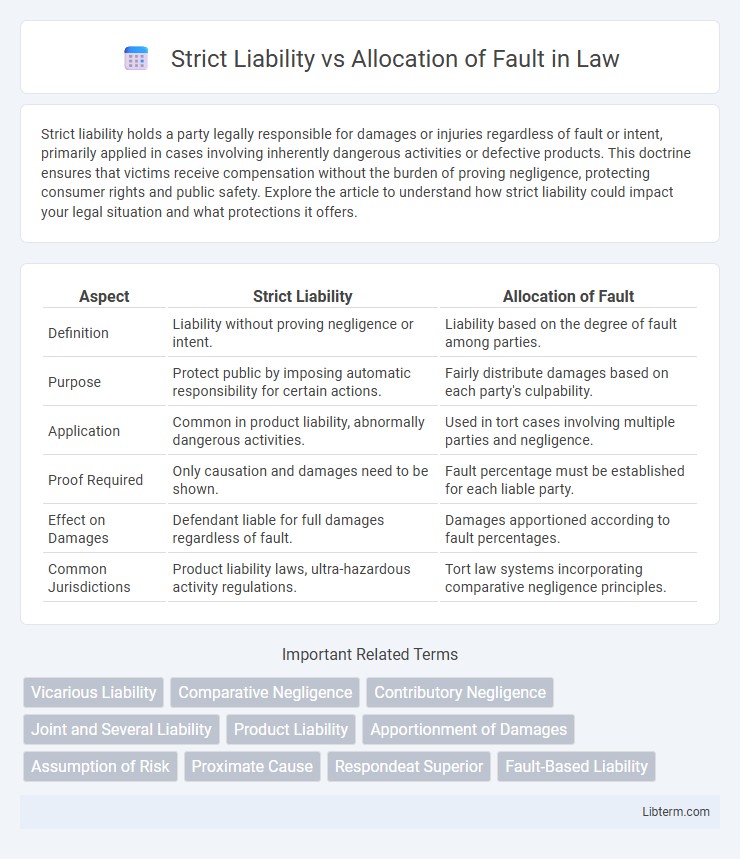Strict liability holds a party legally responsible for damages or injuries regardless of fault or intent, primarily applied in cases involving inherently dangerous activities or defective products. This doctrine ensures that victims receive compensation without the burden of proving negligence, protecting consumer rights and public safety. Explore the article to understand how strict liability could impact your legal situation and what protections it offers.
Table of Comparison
| Aspect | Strict Liability | Allocation of Fault |
|---|---|---|
| Definition | Liability without proving negligence or intent. | Liability based on the degree of fault among parties. |
| Purpose | Protect public by imposing automatic responsibility for certain actions. | Fairly distribute damages based on each party's culpability. |
| Application | Common in product liability, abnormally dangerous activities. | Used in tort cases involving multiple parties and negligence. |
| Proof Required | Only causation and damages need to be shown. | Fault percentage must be established for each liable party. |
| Effect on Damages | Defendant liable for full damages regardless of fault. | Damages apportioned according to fault percentages. |
| Common Jurisdictions | Product liability laws, ultra-hazardous activity regulations. | Tort law systems incorporating comparative negligence principles. |
Understanding Strict Liability: A Legal Overview
Strict liability imposes responsibility on a party regardless of fault or intent, often applied in cases involving inherently dangerous activities or defective products. This legal principle ensures that victims can recover damages without proving negligence, focusing on the risk created by the defendant's conduct. Understanding strict liability helps clarify how courts allocate responsibility, distinguishing it from fault-based systems where negligence or intent must be established.
The Concept of Allocation of Fault in Law
The concept of allocation of fault in law involves determining the degree of responsibility each party holds in causing harm or damages, often applying comparative or contributory negligence principles. Unlike strict liability, which holds a party responsible regardless of fault, allocation of fault assesses negligence to assign proportional liability. This method aims to ensure fair compensation by distributing damages based on the extent to which each party's actions contributed to the incident.
Key Differences Between Strict Liability and Fault Allocation
Strict liability imposes responsibility on a party regardless of intent or negligence, often applied in cases involving inherently dangerous activities or defective products. Fault allocation requires determining the degree of negligence or fault among parties to assign liability proportionally. Key differences include the elimination of fault consideration in strict liability versus the comparative negligence analysis central to fault allocation systems.
Historical Foundations of Strict Liability
Strict liability emerged in early English common law as a departure from traditional fault-based negligence, holding parties responsible for harm regardless of intent or care. This doctrine was historically applied in cases involving inherently dangerous activities or defective products, emphasizing public safety and victim compensation. Its foundation stems from legal principles seeking to simplify litigation and ensure accountability where proving fault is complex.
How Fault Is Determined in Negligence Cases
In negligence cases, fault is determined by evaluating the defendant's breach of a duty of care that directly caused the plaintiff's injury, typically through the "reasonable person" standard. Strict liability, however, imposes responsibility without the need to prove fault or negligence, often applied in inherently dangerous activities or defective products scenarios. Allocation of fault involves comparing the degree of responsibility among multiple parties, influencing the damages each party may be liable for under comparative or contributory negligence laws.
Common Scenarios Applying Strict Liability
Strict liability often applies in scenarios involving inherently dangerous activities, such as using explosives or owning wild animals, where the defendant is liable regardless of negligence. In contrast, allocation of fault typically arises in car accidents or slip-and-fall cases, where liability is distributed based on each party's degree of negligence. Courts apply strict liability to protect public safety by holding individuals or entities accountable for harm from hazardous conditions without requiring proof of intent or carelessness.
Pros and Cons of Strict Liability vs Fault-Based Systems
Strict liability imposes responsibility without requiring proof of negligence, simplifying legal proceedings and ensuring quicker compensation for victims, but it may lead to unfair penalties for defendants lacking fault. Fault-based systems require establishing negligence, promoting fairness by assigning liability aligned with culpa, yet they often result in prolonged litigation and higher court costs due to the complex proof process. The strict liability approach benefits plaintiffs with efficiency and certainty, whereas fault-based models emphasize equitable fault allocation but at the expense of procedural delays and increased legal expenses.
Impact on Plaintiffs and Defendants
Strict liability imposes responsibility on defendants regardless of fault, benefiting plaintiffs by simplifying the burden of proof and increasing chances of compensation. Allocation of fault, used in comparative negligence systems, impacts outcomes by dividing damages based on each party's degree of responsibility, potentially reducing plaintiff recovery if their own negligence is significant. Defendants face higher risks under strict liability, while allocation of fault can mitigate liability by quantifying shared responsibility, influencing settlement strategies and litigation outcomes.
Recent Legal Trends: Shifts Between the Two Approaches
Recent legal trends show a shifting balance between strict liability and allocation of fault in tort law, with several jurisdictions increasingly favoring comparative fault systems to promote fairness in damage distribution. Courts are refining the application of strict liability, particularly in product liability and environmental cases, by incorporating fault-based considerations to better address complex causation issues. This evolution reflects a broader move toward nuanced liability frameworks that integrate both strict liability principles and fault allocation to achieve equitable outcomes.
Choosing the Right Approach: Policy Considerations and Implications
Choosing between strict liability and allocation of fault hinges on policy goals such as deterrence, fairness, and administrative efficiency. Strict liability simplifies proving liability by removing the need to establish fault, promoting consumer protection and encouraging safer practices. Allocation of fault distributes responsibility based on individual negligence, aligning liability with actual conduct but potentially increasing litigation complexity and costs.
Strict Liability Infographic

 libterm.com
libterm.com